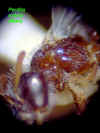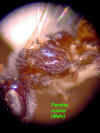Subgenus Hexaperdita (7 species including 3 endemic species, 4
species fall flying)
Key to Hexaperdita. Modified from Mitchell (1960) and Timberlake
(1954)
Females
- Abdomen entirely dark, without pale maculations, or with at most a single
pair of widely separated and very small spots on tergum 2…………2

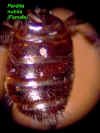

--Abdomen usually with whitish or yellowish transverse spots or bands…..5


- Dorsum of thorax rather densely covered with short, erect , plumose,
ochraceous pubescence; facial maculae extending narrowly up to eye margin
level to antennae….P. georgica

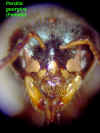
-----Pubescence of dorsum of thorax less dense and more whitish; facial
maculae not reaching above upper margin of clypeus…..3.



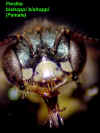
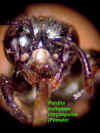
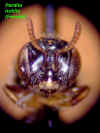
- Wings hyaline or nearly so, veins brownish-testaceous…..4


---Wings milky-white, veins and stigma nearly colorless….P.
nubila
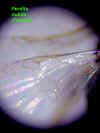
- Clypeus entirely yellow; mandibles and labrum mostly yellow; facial
maculae largely filling space between clypeus and eyes…….P.
bishoppi

-----Clypeus dark in part; mandibles and labrum dark; facial maculae small,
not nearly filling space between clypeus and eyes….P.
boltoniae chrysopsina


- Abdominal terga 2-4 with conspicuous, lateral, transverse, yellow maculae,
those on 2 only slightly separated medially….P.
graenicheri
-----Abdominal maculations limited to terga 2 and 3, and either very narrow
and inconspicuous, or widely separated….6


- Lateral facial maculae extending narrowly along eye margin to level of
antennae; clypeus with dorso-lateral dark areas…7
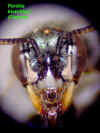
-----Facial maculae whitish, reduced, not extending above upper margin of
clypeus; clypeus usually entirely whitish…..P.
bishoppi

- Wings milky-white, stigma very pale yellow, and veins nearly colorless…P.
foveata
----Wings hyaline, veins relatively dark, brownish, or testaceous……P.
blatchleyi

Males
- Cheeks below tuberculate or spinose…2
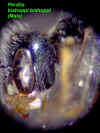

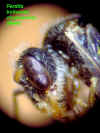
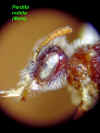
----Cheeks at most only slightly tuberculate….5
- Entire clypeus and conspicuous lateral facial maculae pale yellow….P.
bishoppi

Either the clypeus dark in part, or facial maculae absent…3
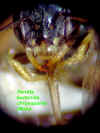
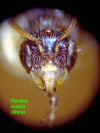
- Head unusually large, much broader than thorax, cheeks swollen, much
broader than eyes, with a rounded angle above and the lower angle produced
and founded…P. foveata
Head only slightly broader than thorax, if at all; ventral angle of cheek
more distinctly tuberculate or spinose…4




- Clypeus more yellow, face with small but distinct lateral maculations
adjacent to clypeus; scape rufo-testaceous or yellow; wings milky-white;
femora and tibia more piceous, markedly contrasting with the yellow tarsal
segments….P. nubila

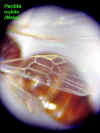
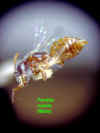
-----Clypeus darker, sometimes without yellow; lateral facial maculations
usually absent; scape piceous or blackish……P.
boltoniae chrysopsina

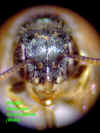
- Cheeks much broader than eyes, more or less angulate below; clypeus ivory,
the lateral maculae broad and extensive, ending acutely on eye margin at
level of antennae…P. georgica
----Cheeks rounded posteriorly, usually but little broader than eyes; abdomen
dark, with at most one pair of very small and inconspicuous pale maculae; some
portions of face below level of antennae dark; lower half of clypeus yellow, the
upper half dark; lateral facial maculae absent (According to Norden et al
(1992), some males do have tuberculate cheeks!)..P.
graenicheri.
Andrenidae: Perdita (Hexaperdita) bishoppi bishoppi
Cockerell
County Records: Alachua, Levy, St. Johns
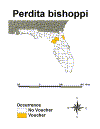
Locations: Ponte Vedra Beach
Dates: Oct. 12-Nov. 24, October:1, November: 4
Plant: Heterotheca subaxillaris; Mitchell lists Heterotheca
and Isopappus (=Croptilon)
Notes: Coastal plain species-North Carolina-Florida-Texas; Flies Aug.-Oct.
Female: 
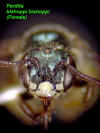
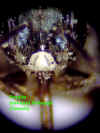
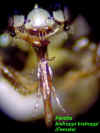
















Male: 

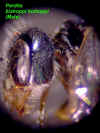






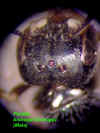










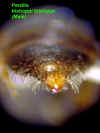


Andrenidae: Perdita (Hexaperdita) blatchleyi Timberlake
County Records: Alachua, Orange, Pinellas, Wakulla
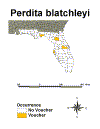
Locations: Winter Park, Dunedin
Dates: Oct. 12-Nov. 1, Oct: 1. Nov:1
Plant: Chrysopsis
Notes: Endemic to Florida. Flies Oct-Nov.
Female: 
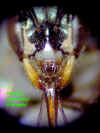
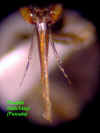










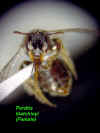



Male: 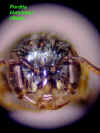


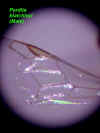

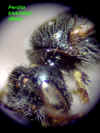


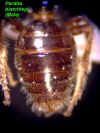

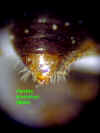
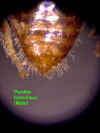
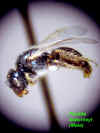

Andrenidae: Perdita (Hexaperdita) boltoniae
chrysopsina Timberlake
County Records: Alachua, Wakulla
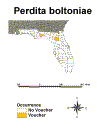
Locations:
Dates: May 2-July 2, May: 2, July: 1
Plant: Erigeron quercifolius; Mitchell also lists Chrysopsis,
Coreopsis, Erigeron, Haplopappus, and Agalinis (as Gerardia)
Notes: New Jersey-Florida, flies July-Oct.
Female: 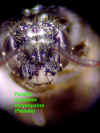













Male: 







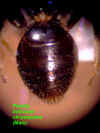
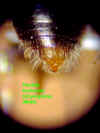
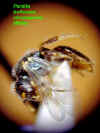

Andrenidae: Perdita (Hexaperdita) foveata foveata
Timberlake
County Records: none in FSCA, Timberlake (1956) does not list it for Florida.
Locations:
Dates:
Plant:
Notes: Flies May-June, disjunct species?
Andrenidae: Perdita (Hexaperdita) georgica Timberlake
County Records: Orange, Volusia, Walton
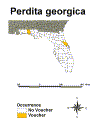
Locations: Daytona Beach, Winter Park, DeFuniak Springs
Dates: Sept. 6-Nov. 1; Sept.: 1, Nov:
Plant: Mitchell lists Aster, Chrysopsis, Haplopappus (Rayjacksonia
or Croptilon), and Heterotheca; Flies August-October, North
Carolina-Florida-Mississippi (coastal plain sp.)
Female: 
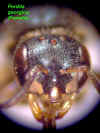
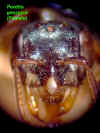
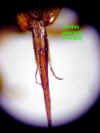
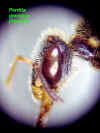












Andrenidae: Perdita (Hexaperdita) graenicheri
Timberlake
County Records: Highlands (Norden et al. 1992); Miami-Dade (Graenicher 1927?)
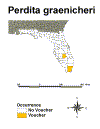
Locations:
Dates: Flies in October (Graenicher); Norden et al. (1992) found it in flight
from late July-early November. Believed to be univoltine
Plant: collected on Chrysopsis tracyi only (Graenicher); Norden et al.
(1992) found it on Heterotheca subaxillaris and Chrysopsis microcephala,
collecting pollen from H. subaxillaris and nectar from both.
Notes: Originally thought to be endemic to SE coast of Florida (Miami-Dade to
Palm Beach?); Recent collections from the central sand ridge area (Norden et al.
1992) have expanded its range to the south-central peninsula. Perhaps, it occurs
in two disjunct areas (the sandy areas of southeastern Florida and the central
sand ridge). Norden et al. (1992) also found much greater morphological
variation in males than that of the original type specimens and males may not
key out using the key in Mitchell. Females key out ok. Males show variation in
head size and gena tubercules, with larger males having tubercules and smaller
males lacking them.
Andrenidae: Perdita (Hexaperdita) nubila Timberlake
County Records: Alachua
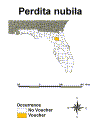
Locations:
Dates: May 1-June 25, May: 2. June:
Plant: Mitchell lists E. strigosus (=Erigeron ramosus), Flies
April-July
Notes: Endemic to Florida. P. nubila may occasionally lack the dense
hairs.
Female: 
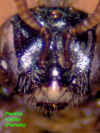







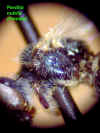


Male: 




